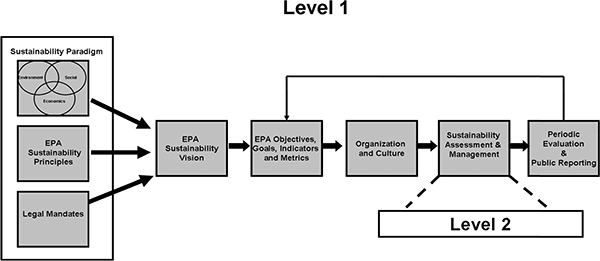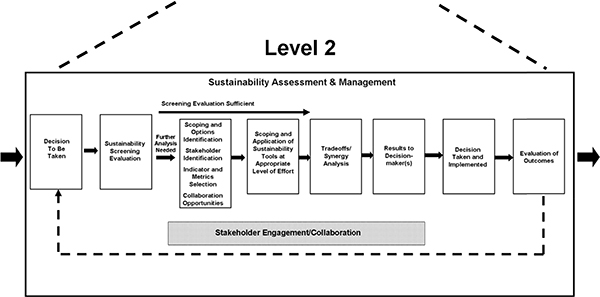In its 2014–2018 strategic plan, the US Environmental Protection Agency (EPA) indicates that its “traditional approaches to risk reduction and pollution control cannot always fully achieve its long-term and broad-environmental quality goals.” The plan describes an agencywide strategy to “advance sustainable environmental outcomes and optimize economic and social outcomes through Agency decisions and actions, which include expanding the conversation on environmentalism and engaging a broad range of stakeholders” (EPA 2014a, p. 55) (see Box 1-1).
Incorporating sustainability considerations into EPA activities involves shifting from approaches focused on a single medium (air, water, or land) to assessments of interactions among humans and natural and manufactured systems. For example, a sustainability assessment of drinking water would go beyond water quality and quantity and perhaps assess the efficiency of water use, the influences of wetlands and other ecosystems, competing societal demands for water (including domestic use and production of food and biofuels), sources of water contaminants (including land use), and climate-change scenarios that affect supply and quality.
BOX 1-1 Cross-Agency Strategy: Working Toward a Sustainable Future
Advance sustainable environmental outcomes and optimize economic and social outcomes through Agency decisions and actions, which include expanding the conversation on environmentalism and engaging a broad range of stakeholders.
EPA will consider and apply sustainability principles to its work on a regular basis, collaborating closely with stakeholders. Our traditional approaches to risk reduction and pollution control cannot always fully achieve our long-term and broad environmental quality goals. The interplay between different environmental statutes and programs also requires renewed attention to improve “synergy” and long-term solutions. To this end, EPA will also embrace a commitment to focused innovation to support solutions that will advance sustainable outcomes. This cross-agency strategy advances the national goal of achieving “conditions under which humans and nature can exist in productive harmony and fulfill the social, economic, and other requirements of present and future generations,” as established in the National Environmental Policy Act of 1969 (NEPA). This goal expresses a foundational concept in the President’s Executive Order 13514, Federal Leadership in Environmental, Energy, and Economic Performance.
To integrate sustainability into the Agency’s day-to-day operations, all headquarters and regional offices will routinely consider the following principles in their decisions and actions, as appropriate:
1. Conserve, protect, restore, and improve the supply and quality of natural resources and environmental media (energy, water, materials, ecosystems, land, and air) over the long term;
2. Align and integrate programs, tools, incentives, and indicators to achieve as many positive outcomes as possible in environmental, economic, and social systems; and,
3. Consider the full life cycles of multiple natural resources, processes, and pollutants in order to prevent pollution, reduce waste, and create a sustainable future.
Source: EPA (2014a, p. 55).
Several years before the present study began, the National Research Council issued Sustainability and the U.S. EPA (NRC 2011a), known also as the Green Book, in response to a request from EPA to strengthen the analytic and scientific basis of sustainability as it applies to human health and environmental protection. The Green Book presents a sustainability framework (see Figure 1-1) that calls for EPA decision-making to consider sustainability options and analyses that cover the three sustainability pillars (social, environmental, and economic domains). The framework includes steps for the selection of sustainability goals, indicators, and metrics. Indicators are measurements that provide quantitative information on important environmental, social, and economic trends (see Chapter 2). Metrics are units of measurement (such as tons of sulfur dioxide emitted per kilowatt–hour) and can be used to define how an indicator is being measured.
The framework also includes a sustainability assessment and management (SAM) approach (see Figure 1-2) to provide guidance to EPA on the sequence of steps for incorporating sustainability into decision-making. The objective is to maximize social, environmental, and economic benefits of a decision and to minimize the adverse effects of conflicts among the three pillars. The SAM process incorporates analysis of alternative options, including assessment of immediate and long-term consequences of alternatives.
The SAM process is a multistep process geared toward major decisions that could affect more than one pillar of the sustainability paradigm. However, it could be scaled down to address more minor or routine decisions. The first step in the process is to evaluate the level of analysis needed for the decision to be made. The next step is problem definition and scoping, which includes identification of options, preliminary planning of the analysis, stakeholder involvement, and opportunities for collaboration. (In general, stakeholders are nterested parties affected by the decision.) The third step involves application of analytic tools. The major results are characterized in terms of tradeoffs and synergies among important social, environmental, and economic objectives to inform decision-makers. After actions are taken, there is followup evaluation of outcomes regarding important aspects of sustainability.
The Green Book recommended that EPA develop a suite of tools for use in the SAM process. “Collectively, the suite of tools should have the ability to analyze present and future consequences of alternative decision options on the full range of social, environmental, and economic indicators. Application of these tools, ranging from simple to complex, should have the capability for showing distributional impacts of alternative options with particular reference to vulnerable or disadvantaged groups and ecosystems” (NRC 2011a, p. 72). Appendix C presents additional information from the Green Book, including the full set of findings and recommendations on the SAM process.

FIGURE 1-1 A sustainability framework for EPA sustainability decisions. Level 1 consists of components that define the agency. Level 2 is the sustainability assessment and management process (see Figure 1-2). Source: NRC, 2011a, p. 37.

FIGURE 1-2 Sustainability assessment and management process. This is a component of the sustainability framework shown in Figure 1-1. Source: NRC, 2011a, p. 37.
After the completion of the Green Book, EPA undertook a number of activities in response to the report’s recommendations (see Chapter 2). In addition, EPA asked the National Research Council to study the use of sustainability tools to elucidate the relationships among economic, social, and environmental aspects in addressing complex issues.
The present committee was asked to examine applications of scientific tools and approaches for incorporating sustainability concepts into assessments used to support EPA decision-making. Using case studies it develops, the committee was asked to consider the application of analytic and scientific tools, methods, and approaches in the SAM process presented in NRC (2011a). It was asked to focus on analytic and scientific tools, methods, and approaches, not to recommend specific policy choices. (The committee’s statement of task is provided in Appendix A.)
THE COMMITTEE’S APPROACH TO ITS TASK
In carrying out its task, the committee considered tools and approaches that EPA can use to operationalize sustainability concepts into assessments that support various agency activities. It is important to note that the committee has been asked to focus n analytic and scientific tools, methods, and approaches. It was not asked to advise EPA on how to address specific science-policy issues by using sustainability analytic approaches. The committee views the identification and development of sustainability assessment tools as an adaptive process of trial and error and continuous re-evaluation of the tools.
Regarding the definition of the term sustainability, the committee used the same definition that was presented in the Green Book and is used by EPA.
Sustainability: “to create and maintain con itions, under which humans and nature can exist in productive harmony that permit fulfilling the social, economic, and other requirements of present and future generations” (NEPA [1969]; EO 13514 [2009]).
The definition indicates that the term sustainability is both a process and a goal. As indicated in the Green Book, “Sustainability is a process because the United States and other countries are a long way from being sustainable, and it is thus necessary to create the conditions for sustainability (NRC 1999). Sustainability is also a goal. As sustainability is achieved in particular places and contexts, it is necessary to maintain the conditions supporting it in the face of social, technological, environmental, and other changes” (NRC 2011a, p. 12). In this report, the committee focused its efforts on sustainability as a process, rather than a goal or a prescriptive end state. The committee considered tools and approaches for analyzing the processes that contribute to three overlapping domains (or pillars): environment, social, and environment, which all contribute to sustaining human wellbeing.
The committee used EPA’s recent report on Sustainability Analytics: Assessment Tools and Approaches (EPA 2013a) as a primary source of sustainability tools and approaches for its consideration. Because that report provides an overview of the data needs, major assumptions, strengths and limitations for each tool, the committee focused on a small set of tools for discussion to illustrate particularly valuable attributes for informing sustainability concepts. The committee also relied on a number of other EPA publications to identify applications of relevance to the agency and to consider how to facilitate the incorporation of the tools and approaches more broadly within the agency.
Using case studies, the committee considered the application of tools and approaches to the SAM process, but it did not attempt to assign tools to certain parts of the process. It focused its attention mainly on the general application of tools within the SAM process. The application of tools specifically for screening is presented in the first case study in Chapter 4, and needed improvements for these tools are discussed in Chapter 6. The report suggests where approaches could be used for postdecision evaluation of outcomes on dimensions of sustainability. However, it does not identify tools and approaches that are specific for evaluation of outcomes.
The committee realizes that implementing its recommendations will require resource expenditures. However, the committee was not asked to and did not attempt to estimate the implementation costs associated with its recommendations.
Chapter 2 discusses factors and trends that are shaping the need for sustainability analytic tools and discusses EPA’s efforts to incorporate sustainability concepts into its activities. Chapter 3 evaluates various tools that could be used to provide support for sustainability decision-making in EPA and identifies needs for improvement. Chapter 4 uses a series of case studies to consider the application of tools, methods, and approaches for incorporating sustainability concepts into EPA activities. Chapter 5 discusses private-sector initiatives and private–public initiatives that are relevant to decision-making in the agency. Chapter 6 considers important new issues that EPA is likely to face in applying sustainability tools and approaches. Chapter 7 discusses the evolving framework for sustainability and EPA decision-making, including opportunities to make sustainability the integrating core of the agency’s strategic planning process and to embed the use of sustainability tools, discussed in previous chapters, into its activities. Chapters 3–7 present recommendations throughout the text; the final sections of those chapters summarize the main conclusions and recommendations.




